Leiden Aratea
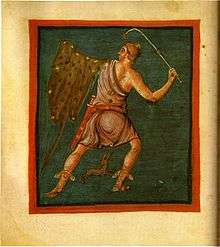
Leiden, Universiteitsbibliotheek, VLQ 79, also called the Leiden Aratea, is an illuminated copy of an astronomical treatise by Germanicus based on the Phaenomena of Aratus. The manuscript was created in the region of Lorraine and has been dated to around 816.[1]
There are 99 extant folios measuring 225 by 200 millimetres (9 by 8 in); four were lost before 1600; this apart, the manuscript is apparently complete. The work contains 39 miniatures including some of the first artistic depictions on paper of the Greek constellations. The artist has made no effort to place the stars correctly according to their positions in the sky so the images cannot be considered true star charts.[2]
History
The Leiden Aratea was created for a wealthy patron, possibly Louis the Pious or his wife Judith. Two copies were made of the manuscript in northern France around the year 1000. Jacob Susius acquired the manuscript in Ghent in 1573. It was owned by Hugo Grotius in 1600 and was used as a source for his edition of Syntagma Arateorum.[3] It was later in the library of Christina of Sweden and was subsequently in the possession of Isaac Vossius. It was acquired by the Leiden University Library along with the rest of Vossius's collection around 1690.
A facsimile was published in 1989. That same year the book was rebound by Lucie Gimbrére.[4] A digital reproduction of this manuscript can be found on Digital Special Collections (DISC) of University Library Leiden:
Manuscript
Constellations, planets and the seasons are depicted in 39 full-page miniatures, all on the verso pages, with corresponding poetical descriptions on the recto. At least five miniatures are lost, including those of the Sun and Moon, Jupiter, and the constellations of Centaurus and Virgo. The illustrations are probably copied from a Late Antique version of Germanicus' treatise; the subjects modeled in a "lively, illusionistic" manner typical of ancient painting.[5]
The text is written in the capitalis rustica script used by the Romans for literary manuscripts and kept by the Carolingians for secular works.[6] An exception is folio 93v, the planetarium, where the routes of the planets are inscribed with quotes from Pliny's Natural History in Carolingian minuscule.[7]
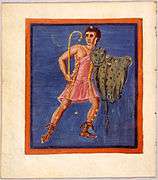 Hercules
Hercules Ophiuchus, Serpens & Scorpius
Ophiuchus, Serpens & Scorpius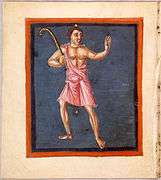 Boötes
Boötes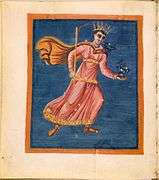 Auriga
Auriga Andromeda
Andromeda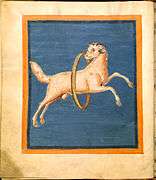 Aries
Aries
Notes
- ↑ Richard Mostert and Marco Mostert, "Using astronomy as an aid to dating manuscripts, The example of the Leiden Aratea planetarium", Quaerendo, 20 (1999): 248–261.
- ↑ Ridpath
- ↑ See the associated prints from Grotius' Syntagma Arateorum on Wikimedia Commons
- ↑ De Hamel, p. 147
- ↑ Katzenstein & Savage-Smith, p. 6
- ↑ De Hamel, p. 148
- ↑ De Hamel, p. 171
Sources
- Walther, Ingo F. and Norbert Wolf. Codices Illustres: The world's most famous illuminated manuscripts, 400 to 1600. Cologne, TASCHEN, 2005. ISBN 3-8228-5852-8
- Katzenstein, Ranee; Savage-Smith, Emilie (1988). The Leiden Aratea: Ancient Constellations in a Medieval Manuscript. Getty Publications. ISBN 978-0-89236-142-7.
- de Hamel, Christopher (2016). Meetings with Remarkable Manuscripts. Allen Lane. ISBN 978-0-241-00304-6.
- Ridpath, Ian. "Illustrating the works of Aratus and Hyginus". Retrieved 2015-11-30.
Further reading
- Weitzmann, Kurt, ed., Age of spirituality: late antique and early Christian art, third to seventh century, no. 190, 1979, Metropolitan Museum of Art, New York, ISBN 9780870991790; full text available online from The Metropolitan Museum of Art Libraries
External links
- Leiden Aratea, bibliographic description and images.